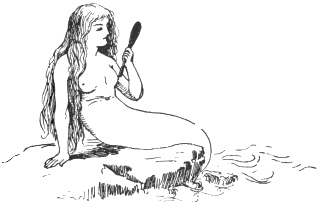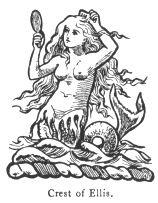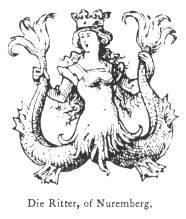
Sacred Texts Legendary Creatures Symbolism Index Previous Next
Buy this Book at Amazon.com


Fictitious and Symbolic Creatures in Art, by John Vinycomb, [1909], at sacred-texts.com
 |
Ellis (Glasfryn, Merioneth).—Argent, a mermaid gules, crined or, holding a mirror in her right hand and a comb in her left, gold. Crest, a mermaid as in the arms. Motto, "Worth ein ffrwythau yn hadna byddir." Another family of the same name, settled
in Lancashire, bears the colours reversed, viz., gules, a mermaid argent.
Sir Josiah Mason.—Crest, a mermaid, per fess wavy argent and azure, the upper part guttée de larmes,
 |
Balfour of Burleigh.—On a rock, a mermaid proper, holding in her dexter hand an otter's head erased sable, and in the sinister a swan's head, erased proper. The supporters of Baron Balfour are an otter and a swan, which will account for the heads appearing in the hands of the mermaid, instead of the traditionary comb and mirror. In some other instances the like occurs, as in the mermaid crest of Cussack, the mermaid sable crined or, holds in dexter hand a sword, and in the sinister a sceptre.
Sir George Francis Bonham, Bart.—Crest, a mermaid holding in dexter hand a wreath of coral, and in the sinister a mirror.
'Wallop, Earl of Portsmouth, bears for crest a mermaid proper, with her usual accompaniments, the comb and mirror. Another family of the same name and bearing the same arms has for crest a mermaid with two tails extended proper, hair gold, holding her tails in her hands extended wide.
In foreign heraldry the mermaid is generally termed Mélusine, and represented with two fishy extremities.
Die Ritter, of Nuremberg bears per fess sable and or, a mermaid holding her two tails, vested gules, crowned or.
 |
A mermaid was the device of Sir William de Brivere, who died in 1226. It is the badge of the Berkeleys; in the monumental brass of Lord Berkeley, at Wolton-under-Edge, 1392 A.D., he bears a collar of mermaids over his camail. The Black Prince, in his will, mentions certain devices that he appears to have used as badges; among the rest we find "Mermaids of the Sea." It was the dexter supporter in the coat-of-arms of Sir Walter Scott, and the crest of Lord Byron. The supporters of Viscount Boyne are mermaids. Skiffington, Viscount Marsereene, the Earl of Caledon, the Earl of Howth, Viscount Hood, and many other titled families bear it as crest or supporters. It is also borne by many untitled families.
The arms of the princely house of Lusignan, kings of Cyprus and Jerusalem, "Une sirène dans une cuvé," were founded on a curious mediæval
legend of a mermaid or siren, termed Mélusine, a fairy, condemned by some spell to become on one day of the week only, half woman, half serpent. The Knight Roimoudin de Forez, meeting her in the forest by chance, became enamoured and married her, and she became the mother of several children, but she carefully avoided seeing her husband on the day of her change; one day, however, his curiosity led him to watch her, which led to the spell being broken, and the soul with which by her union with a Christian she hoped to have been endowed, was lost to her for ever.
This interesting myth is fully examined in Baring Gould's "Curious Myths of the Middle Ages."
The mermaid is represented as the upper half of a beautiful maiden joined to the lower half of a fish, and usually holding a comb in the right hand and a mirror in the left; these articles of the toilet have reference to the old fable that always when observed by man mermaids are found to be resting upon the waves, combing out their long yellow hair, while admiring themselves in the glass: they are also accredited with wondrous vocal powers, to hear which was death to the listener. It was long believed such creatures really did exist, and had from time to time been seen and spoken with; many, we are told, have fatally listened to "the mermaid's charmed speech," and have blindly followed the beguiling, deluding creature to her haunts beneath the wave, as did Sidratta, who, falling in the Ganges, became enamoured
of one of these beautiful beings, the Upsaras, the swan-maidens of the Vedas.
All countries seem to have invented some fairylike story of the waters. The Finnish Nakki play their silver harps o’ nights; the water imp or Nixey of Germany sings and dances on land with mortals, and the "Davy" (Deva), whose "locker" is at the bottom of the deep blue sea, are all poetical conceptions of the same description. The same may be said of the Merminne of the Netherlands, the White Lady of Scotland and the Silver Swan of the German legend, that drew the ship in which the Knight Lohengrin departed never to return.
In the "Bestiary" of Philip de Thaun he tells us that "Siren lives in the sea, it sings at the approach of a storm and weeps in fine weather; such is its nature: and it has the make of a woman down to the waist, and the feet of h falcon, and the tail of a fish. When it will divert itself, then it sings loud and clear; if then the steersman who navigates the sea hears it, he forgets his ship and immediately falls asleep."
The legendary mermaid still retains her place in popular legends of our sea coasts, especially in the remoter parts of our islands. The stories of the Mirrow, or Irish fairy, hold a prominent place among Crofton Croker's "Fairy Legends of the South of Ireland." Round the shores of Lough Neagh old people still tell how, in the days of their youth, mermaids were supposed to reside in the water, and
with what fear and trepidation they would, on their homeward way in the twilight, approach some lonely and sequestered spot on the shore, expecting every moment to be captured and carried off by the witching mere-maidens. On the Continent the same idea prevails. Among the numerous legends of the Rhine many have reference to the same fabled creature.
As we know, mariners in all ages have delighted in tales of the marvellous, and in less enlightened times than the present, they were not unlikely to have found many willing listeners and sound believers. Early voyagers tell wonderful stories of these "fish-women," or "women-fish," as they termed them. The ancient chronicles indeed teem with tales of the capture of "mermaids," "mermen," and similar strange creatures; stories which now only excite a smile from their utter absurdity. So late as 1857 there appeared an article in the Shipping Gazette, under intelligence of June 4, signed by some Scotch sailors, and describing an object seen off the North British coast "in the shape of a woman, with full breast, dark complexion, comely face" and the rest. It is probable that some variety of the seal family may be the prototype of this interesting myth.
The myth of the mermaid is, however, of far older date; Homer and later Greek and Roman poets have said and sung a great deal about it.